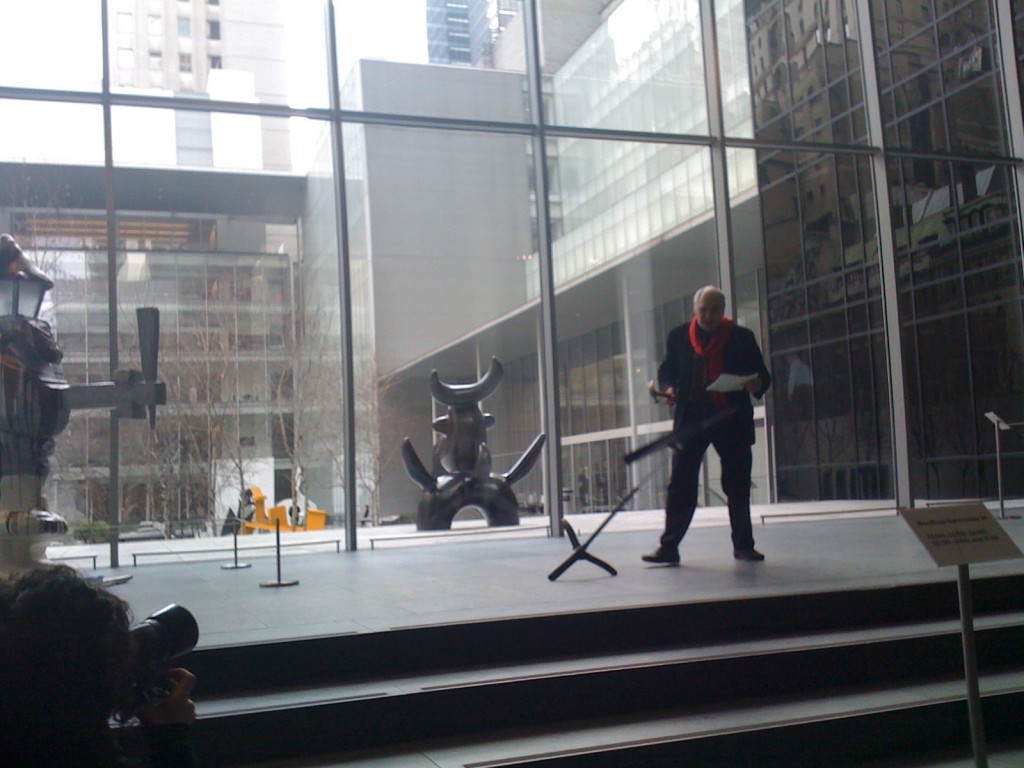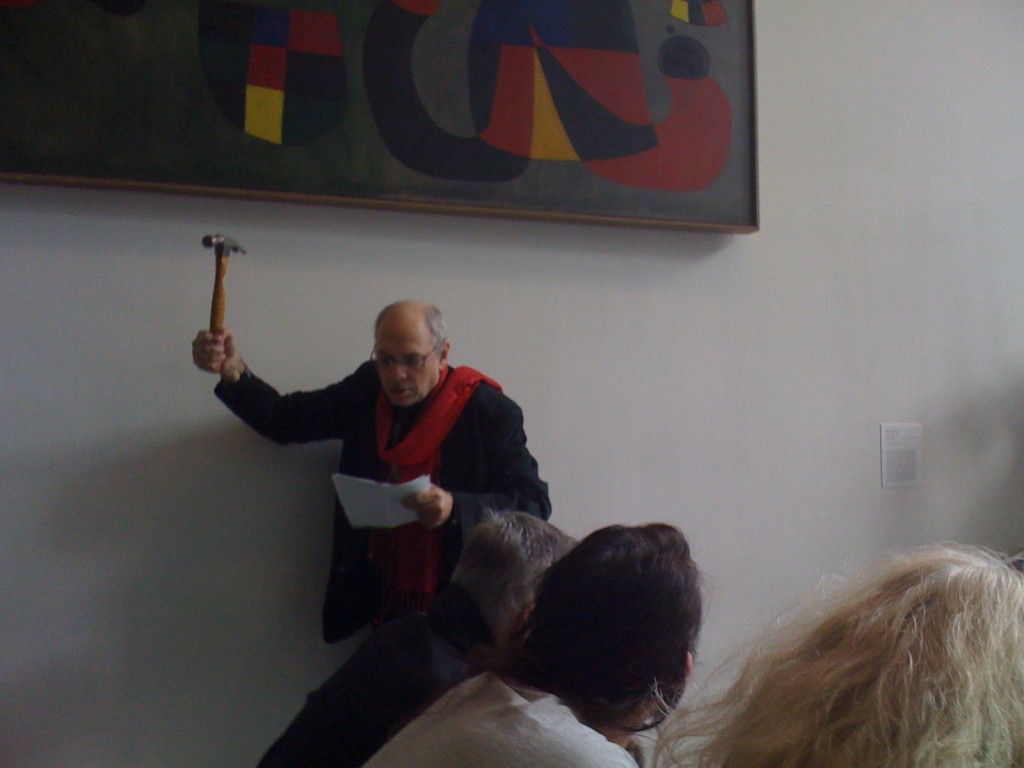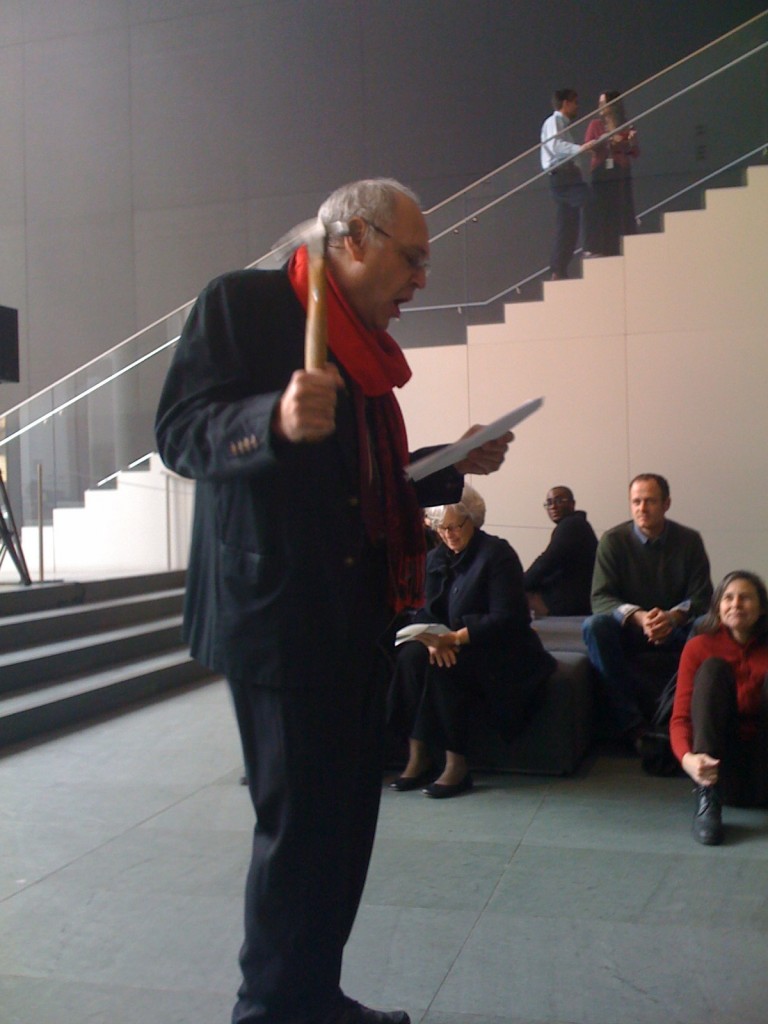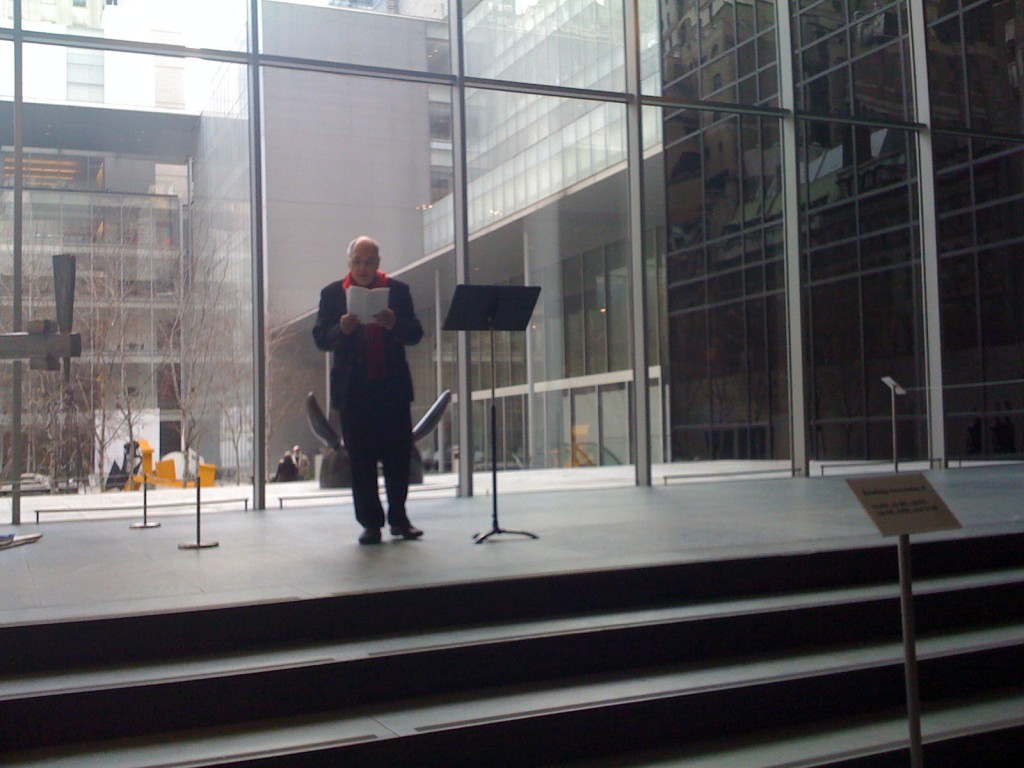Marinetti's Manifesto Meets MoMA
Yesterday at high noon I saw a man wielding a hammer in a glass house & screaming how beautiful speed & war are. That was Charles Bernstein reading F.T. Marinetti‘s The Founding and manifesto of Futurism on the 100th birthday of its publication in the Paris newspaper Le Figaro (see yesterday’s post). Charles did smash the pulpit, but refrained from having a go at the glass walls or at the Matisse, and looking around for something that wouldn’t upset the host of the event, the Museum of Modern Art, he spotted a pile of copies of Poetry magazine (co-sponsor of the event). Instantly recognizing the economic bull-value (hmmm, I thought I had typed “null-value”) of Poetry, poetry, “poetry,” no matter how you spell it, he set them flying with a thorish swing of the hammer. The pile had stoically set there for an hour and more by then, with a sign indicating that they were free for the taking, but it was only after Bernstein had liberated them from their stackness and they had achieved their own random orbits on the floor, that the audience scrambled greedily for freebies (there must be a lesson about poetry in this too).
On a lesss serious note, it was fascinating to realize that this superb piece of manifesteese, which demands the removal, abolition, annihilation, destruction & liquidation of all museums, when read in the context of the MoMA, showed itself perfectly fit to live there. Indeed, you wouldn’t want that manifesto out live in the streets, its proto-fascist tendencies are clear enough (I was surprised more women did not respond to Marinetti’s lines, but maybe Charles’ reading was ironic enough). The conclusion being that nothing fits a museum better than a historical manifesto against museums & for a new & live art. Marinetti’s work did show live greatness later when Thomas Sayers Ellis gave an excellent reading of the sound-poem sections of the Manifetso of the Futurist dance.
On the other hand, when Charles Bernstein read extracts from Mina Loy‘s Aphorisms on Futurism, which date from 1914, it was clear that those texts were as fresh, relevant and live as they were when Loy wrote them. Which made my day.

There goes the Pulpit

Matisse is saved


![Reblog this post [with Zemanta]](http://img.zemanta.com/reblog_e.png?x-id=cac7ad97-30ff-48b8-a181-e4bd86c5b935)

 Poasis II: Selected Poems 2000-2024
Poasis II: Selected Poems 2000-2024 “Todesguge/Deathfugue”
“Todesguge/Deathfugue” “Interglacial Narrows (Poems 1915-2021)”
“Interglacial Narrows (Poems 1915-2021)” “Always the Many, Never the One: Conversations In-between, with Florent Toniello”
“Always the Many, Never the One: Conversations In-between, with Florent Toniello” “Conversations in the Pyrenees”
“Conversations in the Pyrenees” “A Voice Full of Cities: The Collected Essays of Robert Kelly.” Edited by Pierre Joris & Peter Cockelbergh
“A Voice Full of Cities: The Collected Essays of Robert Kelly.” Edited by Pierre Joris & Peter Cockelbergh “An American Suite” (Poems) —Inpatient Press
“An American Suite” (Poems) —Inpatient Press “Arabia (not so) Deserta” : Essays on Maghrebi & Mashreqi Writing & Culture
“Arabia (not so) Deserta” : Essays on Maghrebi & Mashreqi Writing & Culture “Barzakh” (Poems 2000-2012)
“Barzakh” (Poems 2000-2012) “Fox-trails, -tales & -trots”
“Fox-trails, -tales & -trots” “The Agony of I.B.” — A play. Editions PHI & TNL 2016
“The Agony of I.B.” — A play. Editions PHI & TNL 2016 “The Book of U / Le livre des cormorans”
“The Book of U / Le livre des cormorans” “Memory Rose Into Threshold Speech: The Collected Earlier Poetry of Paul Celan”
“Memory Rose Into Threshold Speech: The Collected Earlier Poetry of Paul Celan” “Paul Celan, Microliths They Are, Little Stones”
“Paul Celan, Microliths They Are, Little Stones” “Paul Celan: Breathturn into Timestead-The Collected Later Poetry.” Translated & with commentary by Pierre Joris. Farrar, Straus & Giroux
“Paul Celan: Breathturn into Timestead-The Collected Later Poetry.” Translated & with commentary by Pierre Joris. Farrar, Straus & Giroux
Truly, one can think of NO gesture more richly suggestive of our Language/Post-Language “avant-garde” moment than this: Charles Bernstein declaiming Marinetti’s manifesto in the MoMA, while *carefully* wielding a hammer…
Kent
just for the record- that was a Miro, not a Matisse… in any case, no less of a threat. Thanks for the review!
In a way, I am quite happy to see Moma welcoming any reader of the Manifesto within its magnificent walls. Moma has always been at the forefront of the fight for something new, something which takes us away from those sorry cathedrals of Europe. It is the only museum /art house/airport lounge showing us the path of the Future. I wish I had been there to read the manifesto with Charles Bernstein in a voix de deux which would have pleased Marinetti. We are still in 2009 and we could still do it , maybe when The City rises comes back from the old Europe. Jean-Pierre de Villers
Moma should have an extensive exhibition on Futurism, at least dealing with Futurism in America. It owes it to the memory of Alfred Barr, Lydia Winston-Malbin, and Joseph Stella. It would not be a big affair, most of the most important futurist works are already in the New York area. Stella is at the Newark Museum . It is tim to mov, Moma. Best to you, Jean-Pierre de Villers, July 04, 2009